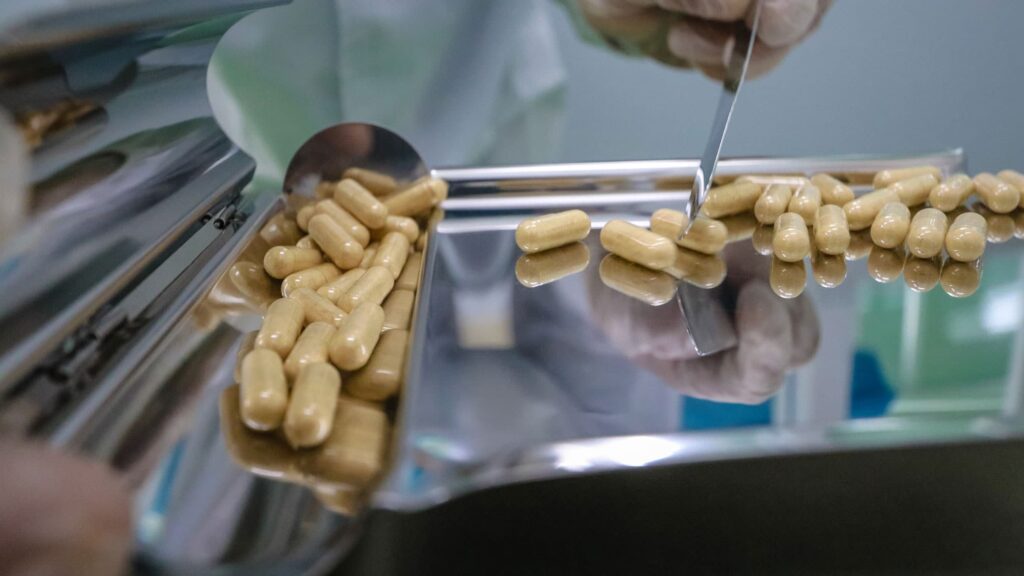Kratom, the tropical evergreen tree native to Southeast Asia, has been renowned for centuries for its psychoactive properties. It is known to have a range of effects on the body and mind, including pain relief, relaxation, and an energy boost.
But what exactly causes kratom’s energizing effects?
The answer lies in the active alkaloids present in kratom leaves – mitragynine and 7-hydroxymitragynine. These two compounds interact with the opioid receptors in our brains, producing a stimulating effect that can increase focus and motivation while reducing fatigue.
[product_blocks id=”58827″]
In this article, we will explore how these alkaloids work together to create kratom’s unique energizing abilities and why it has become increasingly popular as a natural alternative to traditional caffeine-based stimulants like coffee or tea.
The Active Alkaloids In Kratom
Did you know that Kratom is known to give its users a boost of energy?
This phenomenon has been attributed to the active alkaloids present in the herb, Mitragynine and 7-Hydroxymitragynine.
These two compounds are responsible for producing stimulating effects on the body’s nervous system, leading to an increase in alertness, focus, and physical stamina.
While Kratom can provide these energizing benefits, it is essential to note that like any other substance, there are potential side effects associated with its use.
Common side effects include nausea, constipation, dizziness, and headaches.
It is important always to follow dosage recommendations when consuming Kratom as taking too much can lead to adverse reactions such as respiratory depression or liver damage.
With proper usage and cautionary measures taken into consideration, however, Kratom can be used safely while providing users with increased energy levels throughout their day.
Interaction With Opioid Receptors
Kratom’s energizing effects are primarily due to its interaction with opioid receptors in the brain. Kratom contains active compounds called alkaloids, such as mitragynine and 7-hydroxymitragynine, which bind to mu-opioid receptors. These receptors play a key role in regulating pain perception, mood, and energy levels.
Research suggests that kratom’s stimulation of these receptors may produce an increase in dopamine and serotonin release, leading to improved mood and increased motivation. Additionally, endogenous opioids produced naturally by the body may also be involved in this process.
However, it is important to note that long-term use of opioids can lead to tolerance and dependence, so cross-tolerance between kratom and other opioids has been observed.
Overall, while more research is needed to fully understand kratom’s mechanism of action on opioid receptors, it appears that its stimulating effects are largely due to its ability to interact with these pathways in the brain. As with any substance that affects neurotransmitter systems in the brain, caution should always be taken when using kratom or any other supplement for extended periods of time.
Mitragynine And 7-Hydroxymitragynine
As mentioned in the previous section, kratom interacts with opioid receptors in the brain. However, interestingly enough, mitragynine and 7-hydroxymitragynine – two of the primary alkaloids found in kratom – have been shown to have unique effects on these receptors that can lead to an increase in energy levels.
Studies have suggested that mitragynine acts as a stimulant at lower doses by binding to delta-opioid receptors instead of mu-opioid receptors. This results in increased alertness and physical energy without the sedative effects commonly associated with opioids.
On the other hand, 7-hydroxymitragynine has been found to bind primarily to mu-opioid receptors, which are responsible for pain relief and sedation. While it does produce some stimulating effects at low doses, higher doses tend to be more relaxing and calming.
The metabolism of these alkaloids also plays a significant role in their energy-boosting effects. Both mitragynine and 7-hydroxymitragynine are metabolized by liver enzymes before they reach the brain. The rate at which this occurs varies from person to person based on factors such as genetics and liver health.
Therefore, individuals may experience different levels of stimulation or relaxation depending on how quickly their body processes these compounds.
Overall, while kratom’s energizing effects are not completely understood yet, research suggests that they come from the unique interactions between its alkaloids and opioid receptors. By targeting specific receptor subtypes and being metabolized differently than traditional opioids, mitragynine and 7-hydroxymitragynine offer a potential alternative for those seeking natural energy boosts without negative side effects or addictive properties.
Increase In Focus And Motivation
Kratom is well-known for its energizing effects, which have been attributed to the presence of alkaloids like mitragynine and 7-hydroxymitragynine.
These compounds interact with the body’s opioid receptors, leading to increased levels of dopamine and norepinephrine, two neurotransmitters that play a key role in regulating our energy levels.
As such, kratom has become a popular choice among athletes who are looking for a natural way to boost their performance.
Aside from its energizing effects, kratom also offers several benefits for athletes.
[product_blocks id=”58827″]
For one, it can help improve focus and motivation by reducing feelings of anxiety and stress.
Additionally, it has anti-inflammatory properties that can help alleviate pain and soreness after an intense workout.
There are many ways to incorporate kratom into your daily routine – some people prefer to take capsules or tablets while others prefer to brew tea or make smoothies with fresh leaves.
Regardless of how you choose to consume it, be sure to do so responsibly and only under the guidance of a healthcare professional if you have any underlying health conditions.
Natural Alternative To Caffeine-Based Stimulants
Like a warm hug on a chilly morning, kratom has the power to stimulate your senses and wake up your mind. It’s no wonder that people turn to this natural alternative when looking for an energy boost without the jitters associated with caffeine-based stimulants.
But what makes kratom such an effective energizer?
Kratom contains alkaloids like mitragynine and 7-hydroxymitragynine, which interact with the brain’s receptors to produce stimulating effects. This interaction also increases blood flow and oxygenation, providing more energy to the body.
Unlike other herbal supplements, kratom doesn’t cause crashes or adverse side effects, making it one of the safest and most reliable ways to enhance physical performance and mental clarity.
With its array of health benefits ranging from pain relief to anxiety reduction, it’s clear why so many are turning to this ancient plant for their daily dose of vitality.
Frequently Asked Questions
How Does Kratom Affect The Body’s Natural Energy Production?
Kratom is a natural substance that has been found to affect the body’s metabolism and adrenal glands. The active compounds in kratom, such as mitragynine and 7-hydroxymitragynine, have been shown to interact with certain receptors in the brain and nervous system.
This interaction can lead to an increase in energy levels, among other effects. Specifically, kratom may stimulate the release of adrenaline from the adrenal glands, which can cause a temporary boost in energy. Additionally, some researchers believe that kratom may enhance metabolic processes within cells, leading to increased production of ATP (the primary source of cellular energy).
However, more research is needed to fully understand how kratom affects the body’s natural energy production mechanisms.
Are There Any Negative Side Effects Of Using Kratom For Energy?
When it comes to using Kratom for energy, there are potential negative effects that users should be aware of.
While Kratom is known for its stimulating properties and ability to increase focus, it can also cause adverse reactions in some individuals.
For example, studies have shown that Kratom may have a negative impact on heart health when used excessively or over prolonged periods of time.
Additionally, some people may experience increased anxiety as a result of taking Kratom, which can interfere with their ability to stay productive and alert throughout the day.
As such, anyone considering using this herb for energy should speak with their healthcare provider first and take precautions to avoid any potential side effects.
Can Kratom Be Used As A Pre-Workout Supplement?
Kratom has been gaining popularity as a natural energy booster and workout supplement in recent years.
Many users have reported feeling increased energy, focus, and motivation after consuming kratom before exercising.
While more research is needed to fully understand the effects of kratom on exercise performance, some studies suggest that it may improve endurance and reduce fatigue.
However, it’s important to note that individual responses to kratom can vary greatly, and there are potential risks associated with its use.
As with any supplement or substance, it’s best to consult with a healthcare professional before incorporating kratom into your fitness routine.
How Long Does The Energy Boost From Kratom Typically Last?
The duration of energy boost from kratom varies depending on several factors. For instance, the strain and dosage consumed can significantly impact how long you feel energized after taking kratom.
Generally, the effects of kratom last between 2-6 hours, but some users report feeling energized for up to 12 hours or more. Other factors that can affect the duration of energy include tolerance, body weight, metabolism rate, and individual differences in biochemistry.
As a researcher/writer who has extensively studied the effects of kratom on human physiology, I recommend starting with low doses and gradually increasing until you find the optimal dose that works best for your needs.
Are There Any Specific Strains Of Kratom That Are Better For Energy Than Others?
Hey there, fellow kratom enthusiasts! Today we’re diving into the topic of finding the best strains for an energy boost from kratom.
As a seasoned researcher in this field, I’ve found that certain strains like Maeng Da and White Vein are particularly effective for providing a quick pick-me-up to get through those midday slumps. However, it’s important to note that dosage recommendations can vary depending on your personal tolerance and desired effects.
[product_blocks id=”58827″]
When comparing the effectiveness of kratom to other natural energy supplements, such as caffeine or guarana, many users report a longer lasting and more sustained level of energy without the jitters or crash commonly associated with these alternatives.
So if you’re looking for a natural way to power through your day, give some of these best strains a try!
Conclusion
In conclusion, as a kratom researcher and writer, I can confidently say that the natural plant has been shown to increase energy levels in individuals.
Kratom affects the body’s natural production of energy by stimulating the release of dopamine and serotonin, which are neurotransmitters associated with mood regulation and increased motivation.
While there may be some negative side effects associated with using kratom for energy, such as nausea or dizziness if taken in large doses, it can still be used safely and effectively as a pre-workout supplement.
The duration of its energizing effects varies from person to person but typically lasts anywhere from three to six hours.
In terms of specific strains, Maeng Da is known for its potent energizing properties while Green Malay is often recommended for those looking for a more well-rounded experience.
Overall, kratom offers an alternative way to naturally boost one’s energy levels without relying on caffeine or other stimulants.



